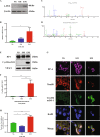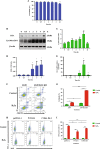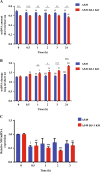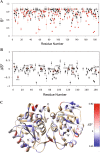The effect of cysteine oxidation on DJ-1 cytoprotective function in human alveolar type II cells
- PMID: 31474749
- PMCID: PMC6717737
- DOI: 10.1038/s41419-019-1833-5
The effect of cysteine oxidation on DJ-1 cytoprotective function in human alveolar type II cells
Abstract
DJ-1 is a multifunctional protein with cytoprotective functions. It is localized in the cytoplasm, nucleus, and mitochondria. The conserved cysteine residue at position 106 (Cys106) within DJ-1 serves as a sensor of redox state and can be oxidized to both the sulfinate (-SO2-) and sulfonate (-SO3-) forms. DJ-1 with Cys106-SO2- has cytoprotective activity but high levels of reactive oxygen species can induce its overoxidation to Cys106-SO3-. We found increased oxidative stress in alveolar type II (ATII) cells isolated from emphysema patients as determined by 4-HNE expression. DJ-1 with Cys106-SO3- was detected in these cells by mass spectrometry analysis. Moreover, ubiquitination of Cys106-SO3- DJ-1 was identified, which suggests that this oxidized isoform is targeted for proteasomal destruction. Furthermore, we performed controlled oxidation using H2O2 in A549 cells with DJ-1 knockout generated using CRISPR-Cas9 strategy. Lack of DJ-1 sensitized cells to apoptosis induced by H2O2 as detected using Annexin V and propidium iodide by flow cytometry analysis. This treatment also decreased both mitochondrial DNA amount and mitochondrial ND1 (NADH dehydrogenase 1, subunit 1) gene expression, as well as increased mitochondrial DNA damage. Consistent with the decreased cytoprotective function of overoxidized DJ-1, recombinant Cys106-SO3- DJ-1 exhibited a loss of its thermal unfolding transition, mild diminution of secondary structure in CD spectroscopy, and an increase in picosecond-nanosecond timescale dynamics as determined using NMR. Altogether, our data indicate that very high oxidative stress in ATII cells in emphysema patients induces DJ-1 overoxidation to the Cys106-SO3- form, leading to increased protein flexibility and loss of its cytoprotective function, which may contribute to this disease pathogenesis.
Conflict of interest statement
The authors declare that they have no conflict of interest.
Figures






Similar articles
-
The relationship between DJ-1 and S100A8 in human primary alveolar type II cells in emphysema.Am J Physiol Lung Cell Mol Physiol. 2019 Dec 1;317(6):L791-L804. doi: 10.1152/ajplung.00494.2018. Epub 2019 Jul 17. Am J Physiol Lung Cell Mol Physiol. 2019. PMID: 31313618 Free PMC article.
-
Structural features of human DJ-1 in distinct Cys106 oxidative states and their relevance to its loss of function in disease.Biochim Biophys Acta Gen Subj. 2017 Nov;1861(11 Pt A):2619-2629. doi: 10.1016/j.bbagen.2017.08.017. Epub 2017 Aug 24. Biochim Biophys Acta Gen Subj. 2017. PMID: 28844983
-
The role of cysteine oxidation in DJ-1 function and dysfunction.Antioxid Redox Signal. 2011 Jul 1;15(1):111-22. doi: 10.1089/ars.2010.3481. Epub 2011 Jan 14. Antioxid Redox Signal. 2011. PMID: 20812780 Free PMC article. Review.
-
The role of DJ-1 in human primary alveolar type II cell injury induced by e-cigarette aerosol.Am J Physiol Lung Cell Mol Physiol. 2019 Oct 1;317(4):L475-L485. doi: 10.1152/ajplung.00567.2018. Epub 2019 Jul 17. Am J Physiol Lung Cell Mol Physiol. 2019. PMID: 31313616 Free PMC article.
-
Redox modulatory role of DJ-1 in Parkinson's disease.Biogerontology. 2025 Mar 30;26(2):81. doi: 10.1007/s10522-025-10227-w. Biogerontology. 2025. PMID: 40159591 Review.
Cited by
-
Persulfidation of DJ-1: Mechanism and Consequences.Biomolecules. 2022 Dec 22;13(1):27. doi: 10.3390/biom13010027. Biomolecules. 2022. PMID: 36671412 Free PMC article.
-
Mitochondrial Ribosome Dysfunction in Human Alveolar Type II Cells in Emphysema.Biomedicines. 2022 Jun 24;10(7):1497. doi: 10.3390/biomedicines10071497. Biomedicines. 2022. PMID: 35884802 Free PMC article.
-
DJ-1 plays a neuroprotective role in SH-SY5Y cells by modulating Nrf2 signaling in response to lidocaine-mediated oxidative stress and apoptosis.Kaohsiung J Med Sci. 2020 Aug;36(8):630-639. doi: 10.1002/kjm2.12218. Epub 2020 May 4. Kaohsiung J Med Sci. 2020. PMID: 32363780 Free PMC article.
-
Chemical Toolkit for PARK7: Potent, Selective, and High-Throughput.J Med Chem. 2022 Oct 13;65(19):13288-13304. doi: 10.1021/acs.jmedchem.2c01113. Epub 2022 Sep 23. J Med Chem. 2022. PMID: 36149939 Free PMC article.
-
Dysregulated Cell Signaling in Pulmonary Emphysema.Front Med (Lausanne). 2022 Jan 3;8:762878. doi: 10.3389/fmed.2021.762878. eCollection 2021. Front Med (Lausanne). 2022. PMID: 35047522 Free PMC article. Review.
References
Publication types
MeSH terms
Substances
Grants and funding
LinkOut - more resources
Full Text Sources
Other Literature Sources
Miscellaneous

